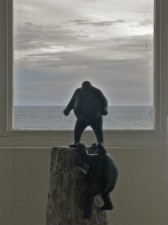Creative alivenes
A shy man plays the piano in his psychiatrist’s waiting room. The psychiatrist sees it as a breakthrough in his treatment, a sign of courage.

Familiar and strange: photo by Howard Gwynne
A woman says she can’t see a psychotherapist unless there is a piano in the room. Is this part of her neurosis or is music the only medium through which her unconscious can find expression?
‘Vermeer, Orpheus and the Blues – a journey into creativity’, was the title of the annual Freud Conference held in Melbourne in May. And the examples above were given by conference organisers, Dr Mark Howard and Dr Michael Parsons, who joined Phillip Adams on his ABC Radio National show, Late Night Live, to talk about the conference and the intertwined themes of creativity, art, music and the inner life that are suggested in its catchy title.
We tend to associate creativity with artistic expression – painting, sculpture, music, literature. “But creativity in the sense of giving meaning, generating meaning in one’s life, is available to all of us,” said Michael Parsons, “it is an intrinsic part of being human.”
Creative aliveness, as Parsons called it, is intensified when “we are open and available to experience that we are not at home with, that is outside our frame of reference.” Freud wrote about this in his essay Das Unheimliche, the ‘un-homely’ or ‘uncanny’. Unheimliche refers to the uncomfortable experience of familiarity and strangeness appearing together at the same time.
The ultimate unheimliche is death. We are surrounded by death and we all know that one day we will die, but what we can’t know is how or when we will die; the experience of death is disconcertingly beyond our grasp.
Rather than provoking fear or denial, being open to the experience of our own death can make us feel more ‘creatively alive’.
As I listened to Michael Parsons I was reminded of the Buddhist practice called ‘last minute consciousness’. As the name suggests, it involves seeing this moment and the next and the one after that, as if it were your last. What a morbid thing to do, some people may think. But, paradoxically, it can be quite liberating, even joyful. The older I get the more I realise that learning to die is the same as learning to live. And for me, learning to live means encountering the myriad beliefs and self delusions that inhibit self expression and feed self doubt. That’s where sisu comes in.
Keeping on going, just turning up, again and again; finding the key that unlocks spontaneity, like the man who played a piano in his therapist’s waiting room, that’s ‘creative aliveness’.


